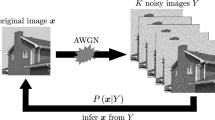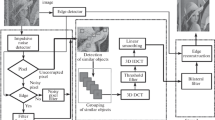Abstract
This paper introduces a new nonlinear filtering structure for filtering image data that have been corrupted by both impulsive and nonimpulsive additive noise. Like other nonlinear filters, the proposed filtering structure uses order-statistic operations to remove the effects of the impulsive noise. Unlike other filters, however, nonimpulsive noise is smoothed by using a maximum a posteriori estimation criterion. The prior model for the image is a novel Markov random-field model that models image edges so that they are accurately estimated while additive Gaussian noise is smoothed. The Markov random-field-based prior is chosen such that the filter has desirable analytical and computational properties. The estimate of the signal value is obtained at the unique minimum of the a posteriori log likelihood function. This function is convex so that the output of the filter can be easily computed by using either digital or analog computational methods. The effects of the various parameters of the model will be discussed, and the choice of the predetection order statistic filter will also be examined. Example outputs under various noise conditions will be given.
Similar content being viewed by others
References
G.R. Arce, N.C. Gallagher, and T.A. Nodes, “Median filter: theory for one- and two-dimensional filters,” in Advances in Computer Vision and Image Processing, vol. 2, T.S. Huang, ed., JAI Press: Greenwich, CT, 1986, pp. 89–165.
R.L. Stevenson and G.R. Arce, “Morphological filters: statistics and further syntactic properties,” IEEE Trans. Circuits and Systems, vol. CAS-34, pp. 1292–1304, 1987.
P. Maragos and R.W. Schafer, “Morphological filters—part I: their set-theoretic analysis and relations to linear shift-invariant filters,” IEEE Trans. Acoust., Speech, Signal Process., vol. ASSP-35, pp. 1153–1169, 1987.
P. Maragos and R.W. Schafer, “Morphological filters—part II: their relations to median, order-statistic, and stack filters,” IEEE Trans. Acoust., Speech, Signal Process., vol. ASSP-35, pp. 1170–1184, 1987.
A.C. Bovik, T.S. Huang, and D.C. Munson, “A generalization of median filtering using linear combinations of order statistics,” IEEE Trans. Acoust., Speech, Signal Process., vol. ASSP-31 pp. 1342–1349, 1983.
J.B. Bednar and T.L. Watt, “Alpha-trimmed means and their relationship to median filters,” IEEE Trans. Acoust., Speech, Signal Process., vol. ASSP-32, pp. 145–153, 1988.
A. Restrepo and A.C. Bovik, “Adaptive trimmed mean filters for image restoration,” IEEE Trans. Acoust., Speech Signal Process., vol. ASSP-36, pp. 1326–1337, 1988.
J. Song and E.J. Delp, “A generalization of morphological filters using multiple structuring elements,” in Proc. 1989 IEEE Internat. Symp. on Circuits and Systems, Portland, OR, May 1989, pp. 991–994.
J. Song, R.L. Stevenson, and E.J. Delp, “The use of mathematical morphology in image enhancement,” in Proc. 32nd Midwest Symp. on Circuits and Systems, Champaign, IL, August 1989, pp. 89–165.
S. Haykin (ed.) Array Signal Processing, Prentice-Hall: Englewood Cliffs, NJ, 1985.
A.N. Tikhonov and A.V. Goncharsky (eds.), III-Posed Problems in the Natural Sciences, MIR Publishers, Moscow, 1987.
T. Poggio, V. Torre, and C. Kock, “Computational vision and regularization theory,” Nature, vol. 317, pp. 314–319, 1985.
S. Geman and D. Geman, “Stochastic relaxation, Gibbs distributions, and the Bayesian restoration of images,” IEEE Trans. Patt. Anal. Mach. Intell., vol. PAMI-6, pp. 721–741, 1984.
S. Geman and D. McClure, “Statistical methods for tomographic image reconstruction,” Bull. Internat. Statist. Inst. vol. LII-4, pp. 5–21, 1987.
A. Blake and A. Zisserman, Visual Reconstruction, MIT Press: Cambridge, Massachusetts, 1987.
T. Hebert and R. Leahy, “A generalized EM algorithm for 3D Bayesian reconstruction from Poisson data using Gibbs priors,” IEEE Trans. Med. Imag., vol. 8, pp. 194–202, 1989.
K. Lange, “Convergence of EM image reconstruction algorithms with Gibbs priors,” IEEE Trans. Med. Imag., vol. 9, pp. 84–93, 1990.
S. Kirkpatrick, C.D. Gelatt, and M.P. Vecchi, “Optimization by simulated annealing,” Science, vol. 220, pp. 671–680, 1983.
P.J. Huber, “Robust smoothing,” in Robustness in Statistics, R.L. Launer and G.B. Wilkinson, eds., John Wiley: New York, 1981.
P.J. Huber, Robust Statistics, John Wiley: New York, 1981.
A. Rosenfeld and A.C. Kak, Digital Picture Processing, Academic Press: Orlando, FL, 1982.
N.C. Gallagher and G.L. Wise, “A theoretical analysis of the properties of median filters,” IEEE Trans. Acoust., Speech, Signal Process., vol. ASSP-29, pp. 1136–1141, 1981.
G.R. Arce and M.P. McLoughlin, “Theoretical analysis of the max/median filter,” IEEE Trans. Acoust., Speech, Signal Process., vol. ASSP-35, 1987, pp. 60–69.
G.R. Arce and R.E. Foster, “Detail-preserving rankedorder based filters for image processing,” IEEE Trans. Acoust., Speech, Signal Process., vol. 37, pp. 83–98, 1989.
J. Jou and A.C. Bovik, “Improved initial approximation and intensity-guided discontinuity detection in visible-surface reconstruction,” Comput. Vis. Graph., Image Process., vol. 4, pp. 292–325, 1989.
R.L. Stevenson and E.J. Delp, “Viewpoint invariant recovery of visual surfaces from sparse data,” submitted to IEEE Trans. Patt. Anal. Mach. Intell., vol. 14, No. 9, pp. 897–909, March 1992.
R.L. Stevenson, G.B. Adams, L.H. Jamieson, and E.J. Delp, “Three-dimensional surface reconstruction on the AT & T Pixel Machine,” in Proc. 24th Asilomar Confron Signals, Systems, and Computers, Pacific Grove, CA, November 5–7, 1990, pp. 544–548.
C. Mead, Analog VLSI and Neural Systems, Addison-Wesley: Reading, MA, 1989.
J.G. Harris, “Analog models for early vision,” Ph.D. thesis, California Institute of Technology, Pasadena, CA, 1991.
P. Penfield, R. Spence and S. Duinker, Tellegen's Theoren and Electrical Networks, MIT Press: Cambridge, Massachusetts, 1970.
W.J. Karplus, “Analog circuits: solutions of field problems,” McGraw-Hill: New York, 1958.
T. Poggio, “Early vision: from computational structure to algorithms and parallel hardware,” in Human and Machine Vision II, A. Rosenfeld, ed., Academic Press: San Diego, CA, pp. 190–206, 1986.
J. Hutchinson, C. Koch, J. Luo, and C. Mead, “Computing motion using analog and binary resistive networks,” Computer, vol. 21, No. 3, pp. 52–62, March 1988.
W.L. Hughes, Nonlinear Electrical Networks, Ronald Press: New York, 1960.
Author information
Authors and Affiliations
Rights and permissions
About this article
Cite this article
Stevenson, R.L., Schweizer, S.M. Nonlinear filtering structure for image smoothing in mixed-noise environments. J Math Imaging Vis 2, 137–154 (1992). https://doi.org/10.1007/BF00118586
Issue Date:
DOI: https://doi.org/10.1007/BF00118586




